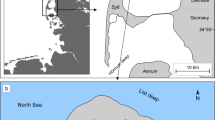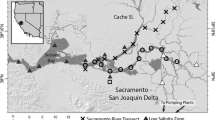Abstract
Experiments were conducted in April–August 1989 on juvenileMercenaria mercenaria (L.) in an oscillatory water tunnel to simulate resuspension of bottom sediments by waves and to determine the effects of shortterm storm events on particle ingestion, pseudofeces production, and shell growth. Juveniles (mean length = 19.2 mm) were subjected to identical concentrations of algae in both low-flow, gentle waves (maximum velocity = 7 cm s−1) and high-velocity storm waves (maximum velocity = 22 cm s−1). Suspended sediment levels reached 193 mg 1−1 at 1 cm above the bed during storms. Shell growth decreased by a maximum of 38% during the storm when levels of phytoplankton were high (average cell concentration = 43 × 106 cells 1−1), and by 18% when phytoplankton levels were low (av cell conc = 6 × 106 cells 1−1). Orientation of clam siphons was not related to flow direction. Significantly more pseudofeces were produced when the clams were subjected to increased sediment resuspension under waves, and in troughs of sand ripples. The size of sediment grains ingested did not vary significantly among the flow treatments. The decrease in shell growth during storms may be due to a reduction in filtration rate coupled with a decrease in net energy gained from filtration due to costs of pseudofeces production. The magnitude of the decrease seems to be related to concentration of algae, water temperature, age of clams and sediment transport mode (bed load or suspended load). Thus, the interpretation of growth increments must be made in the context of these environmental variables.
Similar content being viewed by others
Literature cited
Anderson, F. E. (1972). Resuspension of estuarine sediments by small amplitude waves. J. sedim. Petrol. 42: 602–607
Ashley, G. M., Grizzle, R. E. (1988). Interactions between hydrodynamics, benthos and sedimentation in a tide-dominated coastal lagoon. Mar. Geol. 82: 61–81
Bayne, B. L. (1981). Physiological adaptation in bivalves. In: Calow, P. (ed.) Physiological ecology. Cambridge University Press, Cambridge, p. 178–189
Bayne, B. L., Hawkins, A. J. S., Navarro, E. (1987). Feeding and digestion by the musselMytilus edulis L. (Bivalvia: Mollusca) in mixtures of silt and algal cells at low concentrations. J. exp. mar. Biol. Ecol. 111: 1–22
Bricelj, V. M., Malouf, R. E. (1984). Influence of algal and suspended sediment concentrations on the feeding physiology of the hard clamMercenaria mercenaria. Mar. Biol. 84: 155–165
Bricelj, V. M., Malouf, R. E., de Quillfeldt, C. (1984). Growth of juvenileMercenaria mercenaria and the effect of resuspended bottom sediments. Mar. Biol. 84: 167–173
Craig, M. A., Bright, T. J., Gittings, S. R. (1988). Growth ofMercenaria mercenaria andMercenaria mercenaria texana seed clams planted in two Texas bays. Aquaculture, Amsterdam 71: 193–207
Eckman, J. E., Peterson, C. H., Cahalan, J. A. (1989). Effects of flow speed, turbulence and orientation on growth of juvenile by scallopsArgopecten irradians concentricus (Say). J. exp. mar. Biol. Ecol. 132: 123–140
Eldridge, P. J., Eversole, A. G., Whetstone, J. M. (1979). Comparative survival and growth rates of hard clamsMercenaria mercenaria, planted in trays subtidally and intertidally at varying densities in a South Carolina estuary. Proc. natn. Shellfish. Ass. 69: 30–39
Fréchette, M., Bourget, E. (1985). Food-limited growth ofMytilus edulis L. in relation to the benthic boundary layer. Can. J. Fish. aquat. Sciences 42: 1166–1170
Gordon, J., Carriker, M. R. (1978). Growth lines in a bivalve mollusk: subdaily patterns and dissolution of the shell. Science, N.Y. 202: 519–521
Grizzle, R. E., Morin, P. J. (1989). Effect of tidal currents, seston, and bottom sediments on growth ofMercenaria mercenaria: results of a field experiment. Mar. Biol. 102: 85–93
Grant, J., Enright, C. T., Griswold, A. (1990). Resuspension and growth ofOstrea edulis: a field experiment. Mar. Biol. 104: 51–59
Grant, J., Mills, E. L., Hopper, C. M. (1986). A chlorophyll budget of the sediment-water interface and the effect of stabilizing biofilms on particle fluxes. Ophelia 26: 207–219
Grizzle, R. E., Lutz, R. A. (1989). A statistical model relating horizontal seston fluxes and bottom sediment characteristics to growth ofMercenaria mercenaria. Mar. Biol. 102: 95–105
Hibbert, C. J. (1977). Growth and survivorship in a tidal-flat population of the bivalveMercenaria mercenaria from Southampton Water. Mar. Biol. 44: 71–76
Kennish, M. J. (1980). Shell microgrowth analysis:Mercenaria mercenaria as a type example for research in population dynamics. In: Rhoads, D. C.., Lutz, R. A. (eds.) Skeletal growth of aquatic animals: biological records of environmental change. Plenum Press, New York, p. 255–294
Laing, I., Utting, S. D., Kilada, R. W. S. (1987). Interactive effect of diet and temperature on the growth of juvenile clams. J. exp. mar. Biol. Ecol. 113: 23–38
Lam, R. K., Frost, B. W. (1976). Model of copepod filtering responses to changes in size and concentration of food. Limnol. Oceanogr. 21: 490–500
Lehman, J. T. (1976). The filter-feeder as an optimal forager and the predicted shapes of feeding curves. Limnol. Oceanogr. 21: 501–516
Lofquist, K. E. B. (1977). A positive displacement water tunnel. National Technical Information Service, Springfield, Va. (Misc. Rep. No. MR 77-1 to U.S. Army, Corps of Engineers Coastal Engineering Research Center; CERC Agreement 76-30)
Lofquist, K. E. B. (1978). Sand-ripple growth in an oscillatory water tunnel. National Technical Information Service, Springfield, Va. (Tech. Pap. No. 78-5 of U.S. Army, Corps of Engineers Coastal Engineering Research Center)
Loosanoff, V. L. (1937). Development of the primary gonad and sexual phases inVenus mercenaria Linnaeus. Biol. Bull. mar. biol. Lab., Woods Hole 72: 389–405
Miller, D. C., Sternberg, R. W. (1988). The fluid and sediment-dynamic environment of a benthic deposit-feeder. J. mar. Res. 46: 771–796
Monismith, S. G., Koseff, J. R., Thompson, J. K., O'Riordan, C. A., Nepf, H. M. (1990). A study of model bivalve siphonal currents. Limnol. Oceanogr. 35: 680–696
Moore, P. G. (1977). Inorganic particulate suspensions in the sea and their effects on marine animals. Oceanogr. mar. Biol. A. Rev. 15: 225–363
Peterson, C. H., Fegley, S. R. (1986). Seasonal allocation of resources to growth of shell, soma and gonads inMercenaria mercenaria. Biol. Bull. mar. biol. Lab., Woods Hole 171: 597–610
Peterson, C. H, Summerson, H. C., Duncan, P. B. (1984). The influence of seagrass cover on population structure and individual growth rate of a suspension-feeding bivalve,Mercenaria mercenaria. J. mar. Res. 42: 123–138
Pratt, D. M. (1953). Abundance and growth ofVenus mercenaria andCallocarda morhuana in relation to the character of the bottom sediments. J. mar. Res. 12: 60–74
Pratt, D. M., Campbell, D. A. (1956). Environmental factors affecting growth inVenus mercenaria. Limnol. Oceanogr. 1: 2–17
Purchon, R. D. (1968). Feeding methods and evolution in the Bivalvia. Chapter 3. The biology of the Mollusca. Pergamon Press, Oxford, p. 101–145
Rhoads, D. C. (1974). Organism-sediment relations on the muddy sea floor. Oceanogr. mar. Biol. A. Rev. 12: 263–300
Rhoads, D. C., Boyer, L. F., Welsh, B. L., Hampson, G. R. (1984). Seasonal dynamics of detritus in the benthic turbidity zone (BTZ): implications for bottom-rack mariculture. Bull. mar. Sci. 35: 536–549
Rhoads, D. C., Lutz, R. A. (eds.) (1980). Skeletal growth of aquatic animals: biological record of environmental change. Plenum Press, New York
Rhoads, D. C., Pannella, G. A. (1970). The use of molluscan shell growth patterns in ecology and paleoecology. Lethaia 3: 143–161
Turner, E. J. (1990). Suspension feeding in oscillatory flows with resuspended bottom sediments. Ph.D. dissertation; College of Marine Studies, University of Delaware, Lewes, Delaware
Turner, E. J., Miller, D. C. (1991). Behavior of a passive suspension feeder (Sphiochaetopterus oculatus (Webster)) under oscillatory flow. J. exp. mar. Biol. Ecol. 149: 123–137
Winter, J. E. (1977). A review on the knowledge of suspension-feeding in lamellibranchiate bivalves, with special reference to artificial aquaculture systems. Aquaculture, Amsterdam 13: 1–33
Zar, J. H. (1984). Biostatistical analysis. Prentice-Hall, Inc., Englewood Cliffs, New Jersey
Author information
Authors and Affiliations
Additional information
Communicated by J. M. Lawrence, Tampa
Rights and permissions
About this article
Cite this article
Turner, E.J., Miller, D.C. Behavior and growth ofMercenaria mercenaria during simulated storm events. Mar. Biol. 111, 55–64 (1991). https://doi.org/10.1007/BF01986346
Accepted:
Issue Date:
DOI: https://doi.org/10.1007/BF01986346




